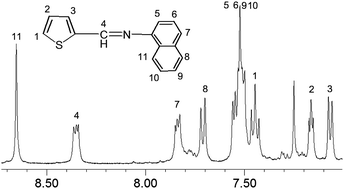Synthesis and characterization of poly-Schiff bases with a donor–acceptor structure containing thiophene units as thermoelectric materials†
Abstract
As representative conjugated polymers, the physical properties, such as electric conductivity and electro-optic properties, of poly-Schiff bases (PSBs) have been widely investigated. However, to date, the thermoelectric (TE) properties of PSB or related polymers remain unreported. In this study, PSB with a donor–acceptor structure (PSB(A)) was synthesized and was blended with different fillers to prepare polymer–inorganic TE composites. For comparison, PSB with the common structure (PSB(B)) was also synthesized, and PSB(B)–graphite composites were fabricated. The PSB(A)/graphite composites exhibited a higher power factor of 10.2 μW m−1 K−2 compared with 4.5 μW m−1 K−2 of the PSB(B)/graphite composites at the same doping level. The effects of different fillers on the TE properties of the PSB(A)-based composites were investigated in detail, and the highest TE figure of merit, ZT = 2.53 × 10−3, was obtained. The results show that excellent TE materials could be produced by preparing polymer–inorganic TE composites using novel conducting polymers with a special structure (e.g., donor–acceptor structure) and conducting fillers.


 Please wait while we load your content...
Please wait while we load your content...